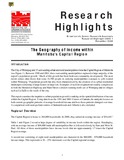| dc.description.abstract | The City of Winnipeg and 15 surrounding urban and rural municipalities form the Capital Region of Manitoba (see Figure 1). Between 1996 and 2001, these surrounding municipalities captured a large majority of the region’s population growth.1 Much of this growth has been bedroom community development. The most recent census data shows that some 16,700 people in outlying municipalities commute to jobs located within Winnipeg.2 Population growth has also been characterized by the creation of ex-urban residential landscapes consisting of large homes on large lots. Examples of such development are readily conspicuous in both the Henderson Highway and Main Street corridors running north out of Winnipeg and in villages such as La Salle to the south of the city.
This report examines the imprint ex-urban population growth is making on the spatial distribution of income within the Capital Region. Using data from the 1991 and 2001 Census of Canada, the analysis focuses on both current geographic patterns of average household income and how those patterns changed over time. A comparison with metropolitan centres of Saskatchewan and Alberta is also included. | en_US |

